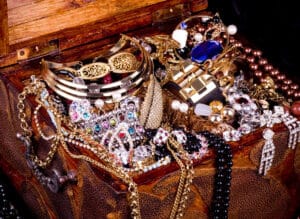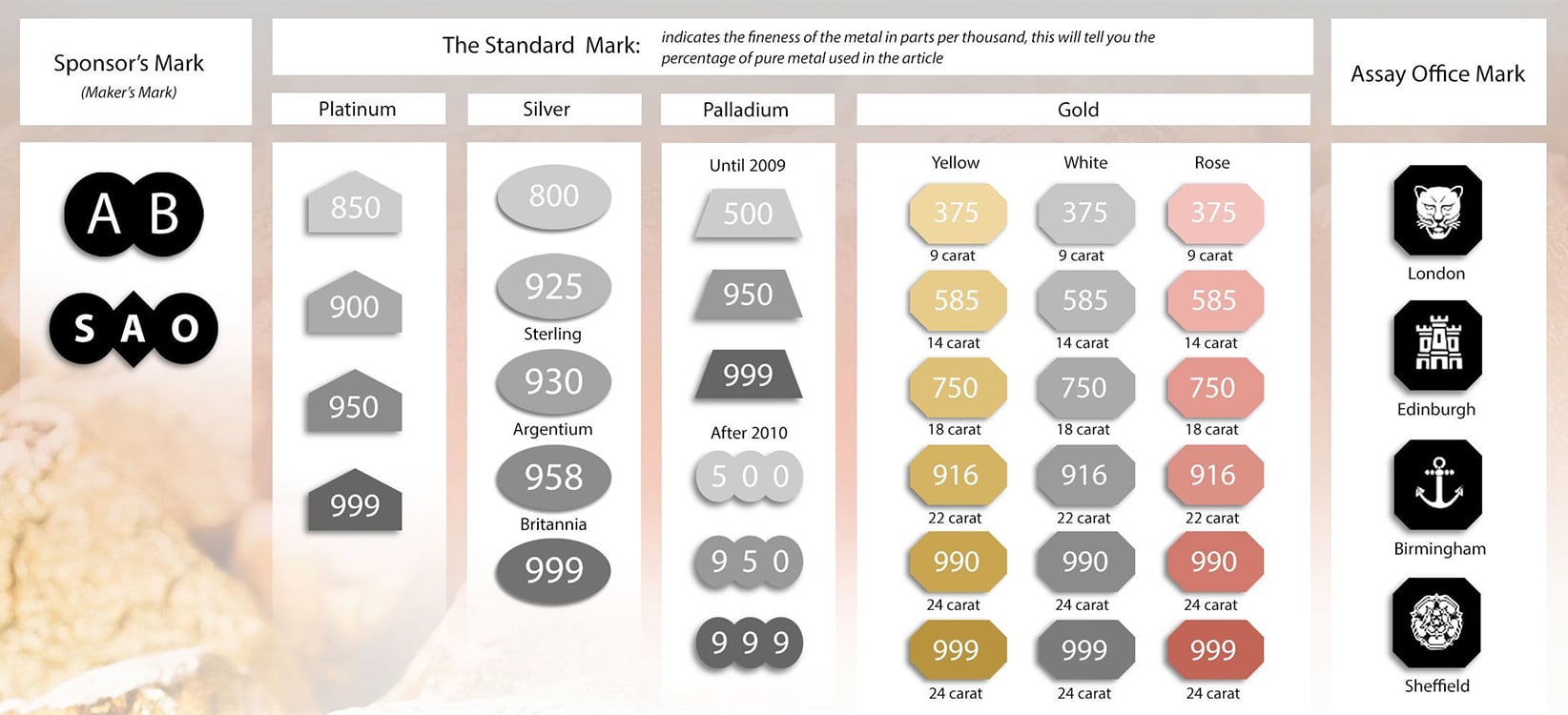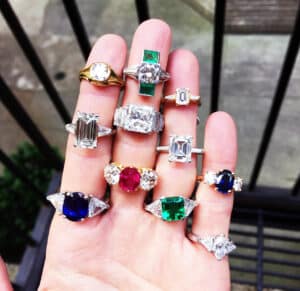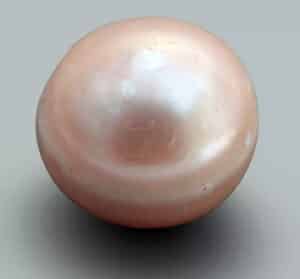by Kary Pardy

How many times have you looked through a jewelry display at your favorite antique shop and was just a bit unsure about the quality or elements of a piece you wanted to get as a gift?
When you’re considering buying antique jewelry or are curious about something you already own, it may seem daunting to learn more, but information can be the difference between a real ring or a costume one, between an heirloom or something that you might wear just for fun. The key to knowing your jewelry, and indeed most antiques, is to use common sense and to think realistically. While it may be more fun to own a gigantic ruby, items are always fake until proven real, and if it seems too good to be true, it can be. But that doesn’t mean you can’t do a little exploring.
Marvelous Metals
Whether you are working with gold, silver, or platinum, your first task is to check if the jewelry is marked. Silver, in its purest form, would be too soft to make functional jewelry. The ideal alloy is 92.5% silver, with the remaining 7.5% being a mix of copper, zinc, and nickel. This mixture is sterling silver. Sterling will commonly be marked with the word sterling, abbreviations such as “ster” or “stg”, or some indication of its silver content, for example, 925, 935, or 835. Early British pieces (95.8 % silver) will feature a series of marks, typically including a purity mark, a city mark, a duty mark, a date letter, and a maker’s mark. If you’d like to track down your piece’s silver marks, the website 925-1000.com is a fantastic resource to identify and date marks from around the world. Chemically, silver can be tested with a magnet (it’s not very magnetic), or with an acid test, which we will examine later in the article.

Is there gold or platinum in your jewelry box? In most cases, gold will be marked with its gold content, or karat (9K, 14K, 18K, 22K, 24K), or it will have a purity stamp which corresponds to what each of those karats means in terms of pure gold content. For example, 14K is 58.5% gold and may be marked 585, or 18K- 75%, marked 750. Platinum follows a similar structure and will be marked with its platinum purity (850, 900, 950, 999).
If there are no visible marks and you want to be more thorough in your testing, you may consider purchasing an acid test kit with a stone, which costs around $15 online. The kit will come with a black stone and several bottles of acid, typically 10K, 14K, 18K, and 22K gold, sterling silver, and platinum. To use, you’ll need to perform a few chemical reactions. Scratch your jewelry a few times on the black stone – it will leave visible streaks. Don’t worry, the scratching won’t damage your jewelry. If testing gold, create several marks on the stone and place one small drop from one gold solution on each mark—working first with the lowest karat solution on upward in ascending order—and watch what happens. If the 10K solution dissolves your first streak, it means that the object is less than 10K or not gold at all. Move on to your next test streak and the next highest amount of acid until you find a solution that leaves the streak intact. For example, if you tested a strip with the 14K solution and it faded very slowly but really disappeared with the 10K, you might have a 12K piece. If your strip shows no visible sign of change when faced with a 14K solution you know that you’re at 14K or higher. A test with one of the higher karat solutions should help narrow it down.
When testing for platinum, make a visible strip on your stone and drop the solution on it. If the piece is indeed platinum, it will remain. If it’s not, it will fade. If it takes a long time to disappear or it turns a rusty color, you may have white gold. You test silver through a similar process, but the results are much more colorful. The acid solution will leave your strip untouched but turn red for fine silver (.999), dark red for 925 sterling, or reddish-brown for 800 silver. Green colors indicate the metal is a lower quality silver containing copper or brass, whereas a brown or yellow reaction that dissolves the strip entirely points to a base metal that is not silver at all. If it sounds a little complicated, don’t worry. Through time and experience, you’ll get a better sense of what colors to look for. Play around with jewelry that is marked and use these pieces as your baseline for what colors to expect, and be sure to check out the wealth of videos online showcasing metals testing.
To value your silver, gold, or platinum, you can easily look up the market price for weight online. Start there and assume an increase for well-known makers. Concerned your piece might be plated? Gold plated items will commonly be marked with GP (gold plated), GEP (gold electroplated), RGP (rolled gold plate), or HGE and HGP (heavy gold electroplate). Silver-plated pieces are commonly marked with EPNS or EP (electroplated, or electroplated nickel silver).
Shiny Stones

Common sense is key when we consider precious stones. Is it likely that a random ring in a costume jewelry box has a real diamond? Not really. Your grandmother passed down a brooch with a blue stone the size of a grape. For most people, that’s probably not a real sapphire. But if faced with these items, we still have a few tricks up our sleeves.
Let’s start with diamonds. If you are examining a loose stone, try the water or the fog test. Diamonds are dense and if you drop one into water, it will sink. If it floats, you’ve got a fake. Similarly, try breathing on the diamond and fogging it up. Diamonds are effective at dispersing heat; the fog should clear up quickly. If it takes several seconds, you’re out of luck. If the diamond is mounted, check how it’s mounted. Real diamonds would have strong settings, likely made of high-quality metal. You can also invest in an electronic diamond tester, a gadget that has saved many a thrift shop owner. They work by measuring how well the diamond conducts heat or electricity and are fairly reliable once you get the hang of using them.
Some of the best tools, however, are a loop and knowledge of what to look for and what makes a diamond special. Diamonds are graded for their carat, color, clarity, and cut. Jewelers will measure carats with special scales or size gauges, but you can’t price a diamond on size alone. Some say that the cut of a diamond is most important because it is what really determines the diamond’s sparkle. Next comes color: the less color, the higher the grade. Clarity refers to any imperfections that may be in the stone. This is least critical because while it will reduce the price, some imperfections are not visible with the naked eye and won’t dampen your enjoyment of your stone. When evaluating diamonds, first do your best to determine if they are real and worth your time, then take them to a professional.
Other Stones
Gemstones are in some ways even more complicated. Use your gut and common sense again, and after that, look at them closely. True gemstones will have imperfections caused by nature; fakes will be pristine and shiny. The best bet with gemstones, though, is to take them to a professional if they pass the common sense test.
Pearls

Pearls are formed over time when an organic invader burrows deep into the soft tissues of a mollusk. The mollusk then coats the intruder with many layers of natural minerals and proteins, referred to as nacre (Nay-Ker). This is what gives pearls their unique appearance, beautiful luster, and color. According to the American Gem Society, most of the ocean’s natural pearls have already been harvested by pearl divers. Today, natural pearls are extremely rare, so this process is re-created by oyster farmers who make cultured pearls.
The factors involved in choosing a quality pearl include color, luster, and the shape of the pearl. Freshwater pearls offer a wider diversity of sizes, shapes, and colors than any other type of pearl. That’s why they are such a popular choice for fancy designer jewelry as opposed to the classic round pearl. A good way to tell if your pearls are real is to rub them across your teeth – if it is coarse, it is most likely real. No two pearls are exactly the same shape and size, and making a graduated in size set of pearls for a necklace takes a sharp eye and a high-end caliper.
Ask for Help
An accredited jewelry appraiser will have taken several courses on all facets of jewelry evaluation and will have the necessary tools to best examine all of your valuable pieces. While we can learn a lot from a basic inspection and a little science, it’s nowhere near the level of precision you’ll get by calling in the big guns. Find a list accredited jewelry appraisers through the Gemological Institute of America (GIA). Visit www.Gia.edu or www.925-1000.com





Related posts: